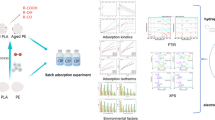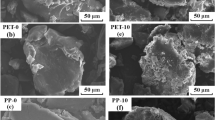Abstract
The photo-aging behavior of microplastics (MPs) in natural environment has become a global concern. The ultraviolet radiation has enough energy to change the polymer structure and physical-chemical properties of MPs. Less attention has focused on the interactions of the photo-aged polar and biodegradable MPs with organic pollutants. This work investigated the structural properties of aged polar polyamide (PA) MPs and biodegradable polylactic acid (PLA) MPs exposed to ultraviolet irradiation and their adsorption behavior and mechanism for neonicotinoid insecticide imidacloprid (IMI). The results showed that the MPs had extensive changes in surface morphology and chemical properties after photo-aging. The C−N bond of PA MPs was disrupted to form more carbonyl groups. The oxygen-containing functional groups on the surface of aged PLA MPs were broken and generated relatively smaller molecules. The adsorption capacity of IMI on PA MPs decreased by 19.2 %, while the adsorption capacity of IMI on PLA MPs increased by 41.2 % after photo-aging. This depended on the natural structure of the MPs and their ability to absorb ultraviolet light. The electrostatic interactions, hydrogen bonds, van der Waals interactions, and polar-polar interactions were the main adsorption mechanisms of IMI on MPs. High initial solution pH and low ionic strength favored the adsorption of IMI by altering charge distribution on the MPs surface. The formation of the humic acid-IMI complexes decreased the concentration of IMI in the water phase and further decreased the adsorption on MPs. These results are enlightening for a scientific comprehension of the environmental behavior of the polar MPs.

Similar content being viewed by others
References
Ateia M, Zheng T, Calace S, Tharayil N, Pilla S, Karanfil T (2020). Sorption behavior of real microplastics (MPs): insights for organic micropollutants adsorption on a large set of well-characterized MPs. Science of the Total Environment, 720: 137634–137640
Atugoda T, Vithanage M, Wijesekara H, Bolan N, Sarmah A K, Bank M S, You S, Ok Y S (2021). Interactions between microplastics, pharmaceuticals and personal care products: implications for vector transport. Environment International, 149: 106367
Bao Z Z, Chen Z F, Lu S Q, Wang G, Qi Z, Cai Z (2021). Effects of hydroxyl group content on adsorption and desorption of anthracene and anthrol by polyvinyl chloride microplastics. Science of the Total Environment, 790: 148077–148085
Bhagat K, Barrios A C, Rajwade K, Kumar A, Oswald J, Apul O, Perreault F (2022). Aging of microplastics increases their adsorption affinity towards organic contaminants. Chemosphere, 298: 134238–134243
Chen Y, Li J, Wang F, Yang H, Liu L (2021). Adsorption of tetracyclines onto polyethylene microplastics: a combined study of experiment and molecular dynamics simulation. Chemosphere, 265: 129133–129142
Duan J, Bolan N, Li Y, Ding S, Atugoda T, Vithanage M, Sarkar B, Tsang D C W, Kirkham M B (2021). Weathering of microplastics and interaction with other coexisting constituents in terrestrial and aquatic environments. Water Research, 196: 117011–117027
Fan X, Zou Y, Geng N, Liu J, Hou J, Li D, Yang C, Li Y (2021). Investigation on the adsorption and desorption behaviors of antibiotics by degradable MPs with or without UV ageing process. Journal of Hazardous Materials, 401: 123363–123373
Yazdani Foshtomi M, Oryan S, Taheri M, Darvish Bastami K, Zahed M A (2019). Composition and abundance of microplastics in surface sediments and their interaction with sedimentary heavy metals, PAHs and TPH (total petroleum hydrocarbons). Marine Pollution Bulletin, 149: 110655–110661
Fu Q, Tan X, Ye S, Ma L, Gu Y, Zhang P, Chen Q, Yang Y, Tang Y (2021). Mechanism analysis of heavy metal lead captured by natural-aged microplastics. Chemosphere, 270: 128624–128632
Gewert B, Plassmann M M, MacLeod M (2015). Pathways for degradation of plastic polymers floating in the marine environment. Environmental Science. Processes & Impacts, 17(9): 1513–1521
Guo X, Liu Y, Wang J (2019). Sorption of sulfamethazine onto different types of microplastics: a combined experimental and molecular dynamics simulation study. Marine Pollution Bulletin, 145: 547–554
Haider T P, Völker C, Kramm J, Landfester K, Wurm F R (2019). Plastics of the future? The impact of biodegradable polymers on the environment and on society Angewandte Chemie (International ed. in English), 58(1): 50–62
Jiang L H, Liu Y G, Zeng G M, Xiao F Y, Hu X J, Hu X, Wang H, Li T T, Zhou L, Tan X F (2016). Removal of 17β-estradiol by few-layered graphene oxide nanosheets from aqueous solutions: external influence and adsorption mechanism. Chemical Engineering Journal, 284: 93–102
Li K, Li L, Qin J Q, Liu X Y (2016). A facile method to enhance UV stability of PBIA fibers with intense fluorescence emission by forming complex with hydrogen chloride on the fibers surface. Polymer Degradation & Stability, 128: 278–285
Li Z, Li J, Tan J, Jiang M, Fu S, Zhang T, Wang X (2022). In situ synthesis of novel peroxo-functionalized Ti3C2Tx adsorbent for aqueous pollutants removal: role of oxygen-containing terminal groups. Chemosphere, 286(Pt 2): 131801–131811
Liang F, Zhang Y, He B, Yang J, Shi Q, Shi F (2022). Enhanced photocatalytic degradation of imidacloprid and RhB by the precursor derived Bi12.7Co0.3O19.35 under different pH value. Journal of Physics and Chemistry of Solids, 164: 110638–110648
Liu G, Zhu Z, Yang Y, Sun Y, Yu F, Ma J (2019). Sorption behavior and mechanism of hydrophilic organic chemicals to virgin and aged microplastics in freshwater and seawater. Environmental pollution, 246: 26–33
Liu S, Shang E, Liu J, Wang Y, Bolan N, Kirkham M B, Li Y. (2022). What have we known so far for fluorescence staining and quantification of microplastics: a tutorial review. Frontiers of Environmental Science & Engineering, 16(1): 8–21
Liu W, Zhang J, Liu H, Guo X, Zhang X, Yao X, Cao Z, Zhang T (2021). A review of the removal of microplastics in global wastewater treatment plants: characteristics and mechanisms. Environment International, 146: 106277–106290
Liu W, Zheng W, Gan J (2002). Competitive sorption between imidacloprid and imidacloprid-urea on soil clay minerals and humic acids. Journal of Agricultural and Food Chemistry, 50(23): 6823–6827
Luo H, Liu C, He D, Xu J, Sun J, Li J, Pan X (2022). Environmental behaviors of microplastics in aquatic systems: a systematic review on degradation, adsorption, toxicity and biofilm under aging conditions. Journal of Hazardous Materials, 423(Pt A): 126915–126930
Luo H, Xiang Y, Li Y, Zhao Y, Pan X (2021). Photocatalytic aging process of Nano-TiO2 coated polypropylene microplastics: combining atomic force microscopy and infrared spectroscopy (AFM-IR) for nanoscale chemical characterization. Journal of Hazardous Materials, 404(Pt B): 124159–124168
Luo H, Zhao Y, Li Y, Xiang Y, He D, Pan X (2020). Aging of microplastics affects their surface properties, thermal decomposition, additives leaching and interactions in simulated fluids. Science of the Total Environment, 714: 136862–136871
Malpass G R P, Miwa D W, Santos R L, Vieira E M, Motheo A J (2012). Unexpected toxicity decrease during photoelectrochemical degradation of atrazine with NaCl. Environmental Chemistry Letters, 10(2): 177–182
Moustafa M, Abu-Saied M A, Taha T, Elnouby M, El-Shafeey M, Alshehri A G, Alamri S, Shati A, Alrumman S, Alghamdii H, Al-Khatani M (2021). Chitosan functionalized AgNPs for efficient removal of Imidacloprid pesticide through a pressure-free design. International Journal of Biological Macromolecules, 168: 116–123
Nguyen T B, Ho T B C, Huang C P, Chen C W, Hsieh S L, Tsai W P, Dong C D (2021). Adsorption characteristics of tetracycline onto particulate polyethylene in dilute aqueous solutions. Environmental pollution, 285: 117398–117406
Razanajatovo R M, Ding J, Zhang S, Jiang H, Zou H (2018). Sorption and desorption of selected pharmaceuticals by polyethylene microplastics. Marine Pollution Bulletin, 136: 516–523
Ren H Q, He Z C, Xu J J, Yan X, Liu P Q (2019). Evaluation of the abilities of ozone resistance for polyamide fibers: structures, properties, and aging mechanism. Industrial & Engineering Chemistry Research, 58(38): 17814–17823
Ren Z, Gui X, Xu X, Zhao L, Qiu H, Cao X (2021). Microplastics in the soil-groundwater environment: aging, migration, and co-transport of contaminants: a critical review. Journal of Hazardous Materials, 419: 126455–126466
Singla M, Díaz J, Broto-Puig F, Borrós S (2020). Sorption and release process of polybrominated diphenyl ethers (PBDEs) from different composition microplastics in aqueous medium: Solubility parameter approach. Environmental pollution, 262: 114377–114384
Vasile C, Pamfil D, Rapa M, Darie-Nita R N, Mitelut A C, Popa E E, Popescu P A, Draghici M C, Popa M E (2018). Study of the soil burial degradation of some PLA/CS biocomposites. Composites. Part B, Engineering, 142: 251–262
Wang F, Gao J, Zhai W, Liu D, Zhou Z, Wang P (2020a). The influence of polyethylene microplastics on pesticide residue and degradation in the aquatic environment. Journal of Hazardous Materials, 394: 122517–122529
Wang F, Wong C S, Chen D, Lu X, Wang F, Zeng E Y (2018a). Interaction of toxic chemicals with microplastics: a critical review. Water Research, 139: 208–219
Wang S, Chen H, Zhou X, Tian Y, Lin C, Wang W, Zhou K, Zhang Y, Lin H (2020b). Microplastic abundance, distribution and composition in the mid-west Pacific Ocean. Environmental pollution, 264: 114125–114132
Wang X, Zheng H, Zhao J, Luo X, Wang Z, Xing B (2020c). Photodegradation elevated the toxicity of polystyrene microplastics to grouper (Epinephelus moara) through disrupting hepatic lipid homeostasis. Environmental Science & Technology, 54(10): 6202–6212
Wang Z, Chen M, Zhang L, Wang K, Yu X, Zheng Z, Zheng R (2018b). Sorption behaviors of phenanthrene on the microplastics identified in a mariculture farm in Xiangshan Bay, southeastern China. The Science of the Total Environment, 628–629: 1617–1626
Xiong Y, Zhao J, Li L, Wang Y, Dai X, Yu F, Ma J (2020). Interfacial interaction between micro/nanoplastics and typical PPCPs and nanoplastics removal via electrosorption from an aqueous solution. Water Research, 184: 116100–116110
Yin Z H, Liu Y G, Tan X F, Jiang L H, Zeng G M, Liu S B, Tian S R, Liu S J, Liu N, Li M F (2019). Adsorption of 17 beta-estradiol by a novel attapulgite/biochar nanocomposite: characteristics and influencing factors. Process Safety and Environmental Protection, 121: 155–164
Zhu C Y, Liu C, Yang J, Guo B B, Li H N, Xu Z K (2021). Polyamide nanofilms with linearly-tunable thickness for high performance nanofiltration. Journal of Membrane Science, 627: 119142–119151
Zou W, Xia M, Jiang K, Cao Z, Zhang X, Hu X (2020). Photooxidative degradation mitigated the developmental toxicity of polyamide microplastics to zebrafish larvae by modulating macrophage-triggered proinflammatory responses and apoptosis. Environmental Science & Technology, 54(21): 13888–13898
Acknowledgements
This work was supported by the National Natural Science Foundation of China (No. 41977142) and Major Science and Technology Program for Water Pollution Control and Treatment (No. 2018ZX07111003).
Author information
Authors and Affiliations
Corresponding author
Additional information
Highlights
• Small molecular chains formed on photo-aged polylactic acid microplastics (MPs).
• Oxygen-containing functional groups generated on photo-aged polyamide MPs.
• Photo-aging has the opposite influence on the imidacloprid adsorption on two MPs.
• Electrostatic interactions and hydrogen bonds were the main mechanisms.
• High pH value and low ionic strength increase the adsorption capacity.
Supplemental Information
11783_2023_1641_MOESM1_ESM.pdf
The adsorption behavior of imidacloprid pesticide on polar microplastics under environmental conditions: Critical role of photo-aging
Rights and permissions
About this article
Cite this article
Liu, W., Pan, T., Liu, H. et al. Adsorption behavior of imidacloprid pesticide on polar microplastics under environmental conditions: critical role of photo-aging. Front. Environ. Sci. Eng. 17, 41 (2023). https://doi.org/10.1007/s11783-023-1641-0
Received:
Revised:
Accepted:
Published:
DOI: https://doi.org/10.1007/s11783-023-1641-0




